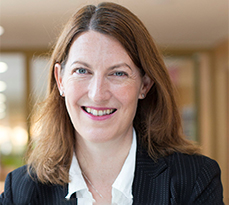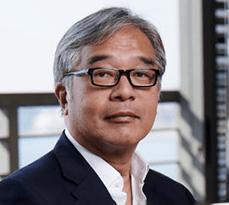by Dr Beth Breeze, Director, Centre for Philanthropy, University of Kent and James Chen, Chen Yet-Sen Family Foundation
Why would any self-aware philanthropist associate themselves with the phrase ‘Moonshot Philanthropy’ at a time when big giving is routinely interpreted as a hubristic and self-aggrandising activity?
Caution in choice of words is wise, given the potential to mix up moonshot philanthropists with those uber-wealthy individuals who dabble in charity but are driven by dreams of colonising Mars. In this article we explain the significant difference, despite the shared planetary allusions, through the story of James Chen whose moonshot goal is to make vision correction available to everyone on planet Earth before anyone sees the red planet up close.

Why call this a ‘moonshot’? The phrase began as a literal reference to President John F. Kennedy’s 1961 challenge to land a man on the moon and return him [sic] safely to Earth before the decade ended. ‘Moonshot’ has now become a metaphor for high-risk goals that are adopted with no idea at the outset of how they will be achieved. If that still sounds like the sort of donor-centric, vainglorious philanthropy that has got up the public’s collective noses and given generosity a bad name, it is worth remembering that the original moonshot goal was achieved as a result of a huge collective endeavour in which a generous budget certainly played a part, but only alongside deep expertise and sustained commitment from a wide range of partners. The reality of the broad effort involved in achieving a moonshot goal is reflected in the tale of John F Kennedy’s visit to NASA headquarters where he met a man mopping the floors and asked about his job: ‘”Mr President,” the janitor replied, “I’m helping put a man on the moon.”‘ Just as the literal ‘moonshot’ of the 1960s space race needed the enduring contribution and commitment of a huge range of people, from those signing off funding, contributing scientific knowledge and risking their lives to go into space, as well as those providing essential support functions, so too ‘moonshot philanthropy’ success is reliant on equally broad collaborations of funders, experts and front-line workers who share the passion and perseverance to make a dream a reality.
In this article we present an example of moonshot philanthropy – advancing universal access to vision correction – that is responsive to concerns about inappropriate and harmful donor-centrism, and demonstrates how philanthropy can play a distinctively useful role in achieving social change by bearing the costs of failure, whilst ensuring the fruits of success are shared by all. This example, which helps to defend the role of philanthropy and explain how big giving works in practice, features a donation to date of $31.5 million, in addition to a substantial proportion of time over 18 years, as well as collaboration with dozens of partners, in order to reach a landmark achievement in July 2021 when all 193 members of the United Nations supported a resolution pledging affordable eyecare for all by 2030.
Through this story we illustrate the three essential elements of achieving meaningful philanthropic ‘moonshot’ goals:
- significant funding and risk appetite;
- developing domain expertise;
- and building respectful collaborations with governmental partners and with other non-state actors.
In highlighting the necessity of all three elements, we underline that money is a necessary but not sufficient factor in moonshot philanthropy and show that this approach can be responsive to scholarly critiques regarding the role of private giving in democratic societies, as well as to generalised public concerns about big donor motivation.

The story of Chen’s ‘moonshot philanthropy’ goal began with a chance encounter in 2003 with an Oxford university physics professor, Joshua Silver, who showed him a prototype of a pair of glasses with fluid filled adjustable power lenses. Having worn spectacles since the age of 16, Chen was aware of their importance for everyday life, and was intrigued by the potential to greatly simplify the distribution complexity and cost of serving low-income populations.
During his early childhood in Nigeria, and in his early career working in developing Asia, he had noticed how few locals wore glasses. Along his moonshot journey, a common but erroneous assumption that the population might have naturally superior eyesight was replaced by an understanding that vision correction was very much needed but simply not available. Indeed, he later learnt that 2.2 billion people – around a third of the global population – have vision impairment, many of whom lack access to affordable eye care. Around 1 billion of these people need little more than a pair of glasses to improve their sight. Knowing how reliant he was on his glasses, and aware that poor eyesight affects every aspect of daily life from reading to driving to social interaction, Chen decided that affordable eyecare for all would become his central philanthropic goal.
The path from that initial philanthropic prompt to the successful vote in the United Nations General Assembly, was by no means smooth. Transforming a sincere but uninformed interest into a meaningful level of subject-specific expertise in eyecare, relevant health policy issues, and how to make social change happen, took many years. Chen’s initial efforts were characterised by stumbles and failures, not least $100 million to date spent on developing an as-yet unsuccessful enterprise with social purpose to produce adjustable power spectacles for both developed and developing markets. A huge effort from 2003 to 2005 to gain support at the World Bank ended in failure. During many meetings with scientists, policymakers, non-profit staff and journalists, Chen regularly took on the task of feeding those gathered, in order to – literally – keep the conversations fuelled, and to live out his personal philosophy that “there’s always room at the table for one more”.
The first significant successful outcome came in 2011 after Chen funded a start-up non-profit organisation called Vision for a Nation (VFAN). VFAN partnered with the Rwandan Ministry of Health, championed by the health Minister Dr Agnes Binagwaho, to deliver vision screening and glasses to the entire nation of Rwanda by 2017, a historic achievement for an emerging low-income country.
Success in Rwanda, along with Chen’s growing understanding of the issues, inspired a shift from direct delivery to advocacy. Sight is fundamental to development and human flourishing: the success of many challenging global issues, from ending poverty, to quality education for all, to gender equality, are all inextricably linked to the prevalence of uncorrected vision. This is because poor eyesight impedes individual productivity and national economic success; prevents children accessing the benefits of education; and disproportionately affects women who have less access to eye care and treatment and more exposure to communicable diseases such as trachoma which are often transmitted through direct contact with children. Challenged by his mother and wife that his next proposed philanthropic investment of (initially) $5million could benefit a million people in need of glasses through funding the VFAN Ghana program, Chen’s retort was that it would still leave 2.199 billion people with vision impairment. With trepidation, his family begrudgingly chose to support Chen to fund a campaign to persuade global leaders to make tackling poor vision a universal priority.
The Clearly campaign began in 2016 with more stumbles and suboptimal outcomes: an attempt to reach policymakers and thought leaders by attending the World Economic Forum in Davos in January 2017 was unsuccessful because the message was lost in the noise of multiple and diverse policy deliberations taking place in Davos. Fortunately, a single-topic summit in Venice in April 2017, where the idea that vision correction is the ‘golden thread’ running through many of the Sustainable Development Goals (SDGs) was successfully conveyed to delegates. The next step was to take a blueprint for success to the Commonwealth Heads of Government Meeting (CHOGM) which took place in London in 2018.
This blueprint emerged from Chen’s growing domain expertise and was written in collaboration with experts and partners. It identified four main barriers to glasses being available to all who need them: diagnosis, distribution, dollars, and demand. In a nutshell, there are not enough trained health workers who can conduct eyesight tests and prescribe corrective lenses; regulations and geographical inaccessibility prevent glasses being easily sold and delivered to those who need them; the cost of glasses – often bumped up by import duties and taxes – makes them unaffordable to vast swathes of the global population; and there is a stigma over wearing glasses in some cultures because they can be interpreted as a sign of weakness, which deters some potential users.
Having laid the groundwork and invested enough time and resource in making a clear, evidence-based case, CHOGM was a success, with all 53 Commonwealth leaders making a commitment to achieve the aim of ‘quality eyecare for all’.
Chen then funded further research to demonstrate the impact of vision correction on the SDGs. The results of a study at a tea plantation in India showed that providing workers with glasses saw a 21.7% increase in productivity. As these results aligned the Clearly campaign squarely with the UN’s central policy initiative, the next step was to propose an initiative to the UN General Assembly.
Contrary to the assumptions of critics, this moonshot philanthropic effort worked with and through policymakers, rather than sought to usurp or supplant them. ‘Plutocracy’ is a word banded around by academic critics of philanthropy who seem unaware that donors wish to prompt or extend, rather than to replace, government action. With the formation of Friends of Vision at the UN, championed by Dr Aubrey Webson, Permanent Representative to the UN for Antigua and Barbuda who is legally blind himself, the reality of a resolution began to take shape and was passed unanimously on 23 July 2021 by all 193 countries of the United Nations. In practice this means that world leaders have agreed a target of ‘eyecare for all by 2030’, and that two specific targets for eyecare will be added at the next review of the Sustainable Development Goals.
Tackling global challenges requires open-ended, emergent strategies that better align with the complex nature of achieving social progress in the face of longstanding and intractable problems that have so far defied successful state or market solutions. Whilst other compound descriptors, such as ‘disruptive philanthropy‘, ‘audacious philanthropy’ and ‘bolder philanthropy’ might unhelpfully suggest a donor-centric vision of how change happens, ‘moonshot philanthropy’ underlines the need to embrace ambition, expertise and collaboration, and usefully encapsulates the ambitious yet essentially vicarious role that big donors play. Despite critics’ concerns about donor hubris, thoughtful philanthropists know that all of their proudest achievements, successes and positive impacts are the result of working with and through partners. This is why philanthropy is a quintessential vicarious activity: JFK did not himself go to the moon, and James Chen is neither a scientist nor a politician, but resources, commitment and collaboration can make good things happen.
A relatively small campaign, funded by an intentionally low-profile philanthropist whose primary motivation, like most donors, is autobiographical rather than reputational, means that 1 billion people currently living with poor vision will benefit from the life-changing power of glasses. As Chen asks: Would Bill Gates have been able to code without his glasses? Would Elton John have been able to play the piano? Would the magical world of Harry Potter ever have been created if J.K. Rowling did not have a pair of specs? These three examples resonate even more when we recall that Gates, John, and Rowling have all led significant and successful philanthropic initiatives in addition to their professional successes.
Populist concerns about the motivations of richer donors incorporates an assumption that big giving advances class interests, hence the accusation that philanthropy is an ‘elite charade’ funding ‘fake change’ that reinforces existing power structures. Such critics are likely unaware that moonshot donors face questions and concerns from within their closest circles. Just as JFK had to persuade Congress to fund the space race, Chen’s wife and mother questioned his priorities and plans for using family money in which they had a stake. If class interests were so easily advanced, internal family politics and dynamics would not be such a challenging aspect of philanthropy.
We believe this example usefully illustrates moonshot philanthropy and helps to counter common criticisms of big giving. To recap: the three key elements of ‘moonshot philanthropy’ are:
- Sufficient funding and risk-appetite to absorb failures and dead-ends.
- Perseverance and willingness to commit as much time as needed to achieve domain expertise.
- Ability to build respectful partnerships in which strategy is co-created and donors are humble enough to ‘mop the floors’ – or in Chen’s case, keep partners well fed – when that is what is needed to achieve the ultimate, shared goal.
Critiques of philanthropy typically focus on only the first element – the money – which is understandable but unhelpful. Money alone cannot achieve anything, but lots of things cannot be achieved without financial support. That is why we need to explain the real role that philanthropy can and does play.
It is easy to forget that the idea of putting a man on the moon was considered indulgent and utterly fanciful by many. The response to John F Kennedy’s commitment was not universal acclaim: his presidential predecessor Dwight D. Eisenhower described the plan as “just nuts”. Reversing climate change, curing cancer, ending world hunger, and universal vision correction, are all monumental challenges. But as the original moonshot demonstrated: they are possible with the right investment of expertise, risk capital and time.
There is a final reason that ‘moonshot philanthropy’ is a helpful phrase: just as JFK and the astronauts were successful but flawed people, so too (of course) are philanthropists. At the core of populist critiques of philanthropy is the ‘revelation’ that big donors are fallible humans who make mistakes. Chen is happy to agree that, like everyone else, he is not a perfect human being. We are all a work in progress, but the pursuit of moonshot philanthropy is one way to ensure that whilst lying in the gutter, some big donors are looking to the stars.


